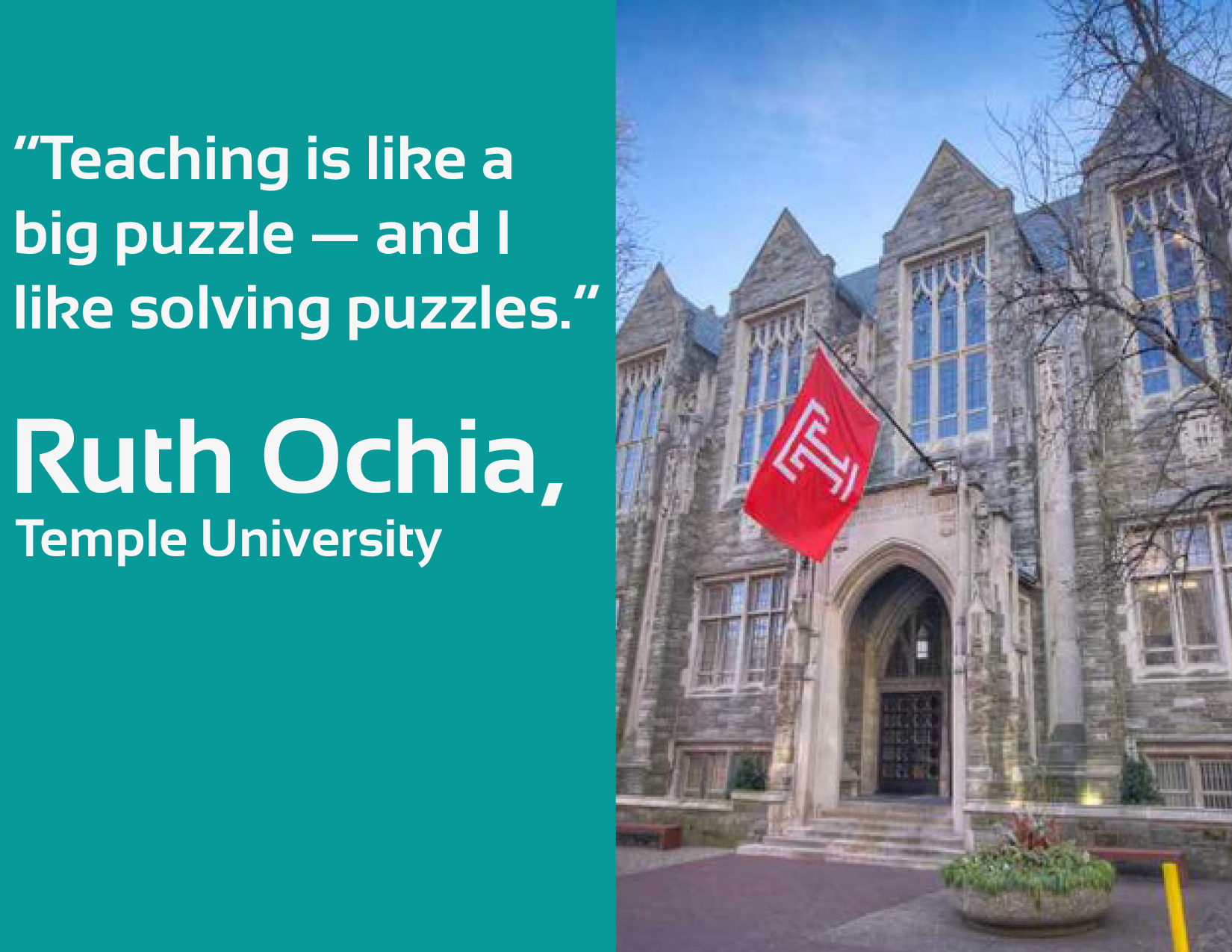
This week we continue our series highlighting educators within the VentureWell network that are doing good work—faculty members that are challenging norms in higher education and inspiring students to impact the world through invention.
This month’s faculty spotlight is Ruth Ochia, Associate Professor of Instruction in Bioengineering at Temple University. Ruth is a charter member of our Pathways in Innovation program.
How did you get interested in teaching entrepreneurship?
Temple University got into the Pathways in Innovation program through the College of Engineering. I was a coordinator in Senior Design for Bioengineering at the time and all of the coordinators were introduced to the Pathway concepts. I never thought that entrepreneurship was a thing engineers did, let alone tried to teach in college.
Each coordinator was asked to include innovation and entrepreneurship into their other courses (outside of senior design). I really found the concepts of Design Thinking to be a great fit for what we were trying to teach our undergraduate engineers. I started by introducing “needs assessment,” basically defining the problem, which is the first step in Design Thinking process, in my freshmen introductory course, Frontiers in Bioengineering. This dovetailed nicely with the work being done in senior design. Now I’m working to bridge the gap between freshmen and senior years with entrepreneurship ideas.
 What is your favorite thing about teaching?
What is your favorite thing about teaching?
To me teaching is like a big puzzle—and I like solving puzzles. How do you get other people to pull together prior knowledge, mix with new information and concepts, and then be able to springboard from the new foundation to the next step? Unfortunately there are so many variables you can’t account for at the start of any semester: something that worked really well last semester can totally bomb this semester because the students are different. It is a joy and completely frustrating at the same time. It makes life interesting.
What is your least favorite thing about teaching?
Grading. I guess pretty much every teacher says the same thing. I want to say that learning is the most important thing and the grade won’t matter in 5-10 years, but many students don’t see it that way. This semester I attempted to add Problem Based Learning (PBL) into my junior mechanics course in order to get students to think about more open-ended problems, which is what they will see in the workplace. The results were very mixed. One student wrote that he/she didn’t like PBL as it didn’t have anything to do with problems that were done in class or were on the exams. The student was correct. How do you restructure engineering education to teach to the unknown and changing future?
Where would you like to see the field of entrepreneurship in five years?
In terms of engineering, I think that entrepreneurship needs to be integrated in the education of our students. I used to think that entrepreneurship was about running a business, but it is so much more. Now the challenge is to get students to realize that entrepreneurship is about understanding the end-user needs and thus problem solving, which is the part that engineers like. Such an understanding appeals to students at all levels and could help keep students in engineering majors.
What traits make for great teachers, advisors or mentors?
There needs to be a willingness to listen, empathize, and facilitate. We can make suggestions, make introductions, and get students to think about their future paths, but that is as far as we should go. As the saying goes, “You can lead a horse to water, but you can’t make it drink.” The ultimate decisions on a student’s future direction lie with the student. However, the exciting part is that we work with all types of students because you never know what type of positive impact you will have on the life of a student.
What books on entrepreneurship and innovation have you been reading lately?
I have been working on BioDesign: The process of innovating medical technologies by Paul Yock and Stephanos Zenios. It’s a tome that isn’t quite “light” reading. In addition, I really enjoyed reading Drive: The Surprising Truth About What Motivates Us by Daniel Pink. My interests lie in how to motivate students, especially within the realm of engineering education.
What’s your most useful classroom activity or assignment?
In my introductory course, I work on students developing a sense for defining problems. So I’ve started showing pictures that contain many potential issues. The students are asked to define the issues they can see and what questions they would ask or additional information they would want to help define the problems. They always want to start with solutions, but the key is to get them to define the problem better, which is half the work of solving the problem anyway.